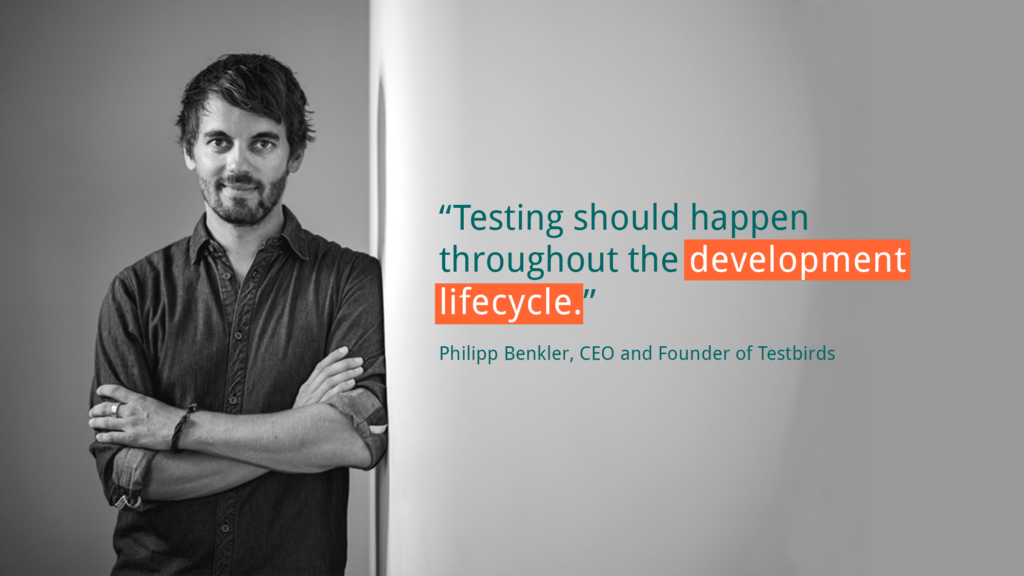Are you thinking about testing the quality of your digital product but don’t know where to start? That’s why we’ve compiled the most important steps of conducting a successful QA test.
In our last blog article “What is QA Testing and Why Do We Need It?” you found out about the different forms of QA tests and why a bug-free digital product is so essential in today’s times. To dive deeper into the topic, Philipp, our Co-Founder and CEO, gives you tips on how to conduct successful QA tests in our masterclass in cooperation with Business Reporter. Get a first insight in the video below:
What You Need for Successful QA Testing
1st Step: Make Testing A Priority
Being a company called Testbirds, that sells testing services, surely we want everybody to make testing a priority… isn’t that what you just thought?
Of course you’re right, but the reason behind it goes beyond financial benefit. We really believe that customers – your customers – will benefit from you making testing a priority. And here’s why!
When testing isn’t a priority it usually happens at the very end of the development life cycle, right before release. This means the testers (whoever they are) get a fully developed product and the task will mainly be to check for critical bugs and errors. That’s good, but not good enough.
Imagine how much valuable feedback you’ve been missing in all previous development phases. That’s why it’s so important that testing happens throughout the whole development life cycle and not just at the very end of it.
2nd Step: A Robust Test Plan That Fits the Development Life Cycle
I know – you have tight development sprints that are executed weekly or bi-weekly; never enough time, budget, or resources; and now I’m telling you that you need to add testing to each step of development too?
Yes I am and yes you do – and I’ll tell you why in just a minute.
First, let’s have a quick look at the different steps of the development life cycle – although I’m sure you know them by heart already.
So usually, testing starts after development, with a finished – or almost finished – product. But just think about all the valuable feedback you could have gathered in previous phases.
Don’t you think it would make sense to start your concept with a good understanding of what your competitors do, how they do it, and what your potential customers like or dislike about it? Wouldn’t that be a great way of finding the right approach for your digital product? I think it surely would.
And what about a first round of feedback on your prototype? Wouldn’t it help to see if people find what they’re looking for, to let them help you with categorisation? Or imagine you could let your target group test two different versions of your future product and tell you what they like or dislike – that would be very useful during development, wouldn’t it?
At Testbirds we know that hitting the market with a new digital product is always thrilling, but also a bit of a lucky bag. We also know that testing helps you minimise the risks. Because the better you know your target audience, by letting them test and give feedback throughout the entire product development cycle, the higher the chances are that you will create and release a digital product that people really love.
3rd Step: Be Aware of Operational Blindness
Another point that often isn’t sufficiently taken into consideration during testing is the aspect of operational blindness. In most companies, in-house developers will be responsible for testing the product they just coded. Let’s be honest, is this really useful? Of course, they can check the core features and will probably find basic bugs – but developers, and even your own staff, are too close to your product and therefore aren’t able to give unbiased feedback.
All of them know your product too well and will surely use and look at it differently than your end-user who sees it for the first time. Say hello to operational blindness in its purest form.
That’s why we believe that innovative testing also means including the end-user, your target group, in your tests. Only with their unbiased feedback will you get to the bottom of the real problems and crucial issues before release.
Your product owners and developers will be amazed (and perhaps shocked) how end-users find their way through your product – let me assure you, it’ll be different from what you expected.
4th Step: Have all devices available
What do you think – how many combinations of devices, software, operating systems, and browser versions are out there?
There’s no official number, but let me give you an idea.
According to Strategy Analytics there were 22 billion devices connected to the Internet in 2018. OperatingSystem.org currently lists 613 operating systems and 663 Linux distributions. Well, I guess you can already see where this is going – it’s a lot of combinations.
I know, now you’ll tell me that there’s no need to test on each and every single combination. But even if we just look at the major ones like Windows, MacOS, Linux, and iPhone and Android – with all those different devices and different versions of OS and browsers, your in-house device farm will soon be huge (and here we assume that you have an unlimited budget).
So, let’s just think hypothetically that you could have all devices with all software and browser versions ready – who would be able to test your digital product on all of them? Well, I guess, no one is the only answer here.
No one? Really? But there must be a way? Of course there is. Find a group of people – let’s call them a “crowd” 😉 – that has the most common devices at hand and let them test your product for you.
5th Step: Internal Buy-in from All Stakeholders and Business Owners
Okay, now you’ve made testing a priority, you have a test plan, you’ve understood that testing is important in every step of the development cycle, you’re aware that you need more than just your own staff to test your products, and you know that you can’t have every device-OS-browser combination in your in-house device farm. What now?
Now, you need to convince everybody in your company of those facts. Because as long as only you and a few others believe in innovative testing methods, nothing will change. That’s why you need the buy-in from all stakeholders and business owners. Just tell them what I just told you. That should be quite convincing, at least it convinced you to read this far – didn’t it?
How to Solve the Challenges of Testing
I guess now you’re curious how to solve the issues I mentioned? You’re convinced that traditional testing methods are a good base but you’ve also realised that they’re just not enough anymore.
We need a way of smarter testing that helps us solve those limitations and weaknesses. Luckily, there is one: Crowdtesting.
Crowdtesting offers you the possibility to get your products tested in every stage of the development life cycle. Choose your target group with the help of 65 demographic criteria and get feedback from your real end-users. Additionally, our 400,000 Crowdtesters have more than 900,000 devices on hand, which they test your digital product on. So, the growing device landscape shouldn’t be an issue anymore.
For a testing solution that’s right for you, you should find a flexible partner for your tests. Let’s say you have just a little or no experience at all with QA tests, then it’ll be useful to let your partner show you how to build a test script, manage the community, run the test, and how to analyse the final results. And then, when you’re feeling more comfortable, you can do more on your own.
If you do have experience with QA testing, you can choose to be as involved in testing as you want to be. If you want to set things up and run your tests on your own, you can. If you feel like you don’t have enough time or resources, you can let your partner take care of things. Nevertheless, your flexible partner (yes, that’s us) will be by your side to help out when you need it.
Do you want to learn more about successful QA Tests? Then watch the full Masterclass, now!
Share it if you like it:
Tag Cloud
About the author
When Simone is not working on superb texts for Testbirds, she and her horse live it up on the tournament areas in Bavaria.
Categories
Links
Rate this post
Other content that might be interesting for you:











